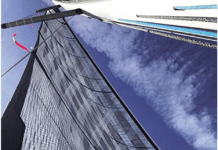PDQ 32
The PDQ 32 was introduced in 1996. The concept was to offer a smaller, lighter and less expensive alternative to the PDQ 36. One of the things we like about PDQ boats is the quality materials and generally clean workmanship. A modified epoxy resin (AME 5000) and tri-axial knitted fiberglass fabrics are used in the hull and deck. The mast is supported in part by a carbon fiber-reinforced deck beam. The hulls are solid glass below the waterline and cored with Klegecell foam above the water, an arrangement we think makes a lot of sense. Each hull has an air-tight comparatment forward, which provides a measure of safety in the event of collision, and the keels also have sacrificial sections. When you poke around in lockers, you don't see a lot of unfinished glass.
Caliber 33
The Caliber is a peculiar blend of tradition and innovation, of security and performance, of practicality and pizzazz. All of the owners we heard from were "satisfied." One called the 33 his favorite boat over six decades of sailing.
Beneteau Oceanis 350
Beneteau is the largest builder of sailboats in the world. The French company has made its mark not only in Europe, but in the U.S. as well, opening some years ago a plant in Marion, South Carolina, with headquarters in Charlotte, North Carolina. Probably more than any other company, Beneteau also has influenced sailboat styling--the so-called Euro-style, typified by smoked wrap-around windows, scoop transoms with molded-in steps, and lots of curvy interior shapes. The Oceanis 350, built between 1986 and 1993, is a reasonable example of Beneteau's impact on the sailboat market. About 144 were built in the US, more in Europe.











































